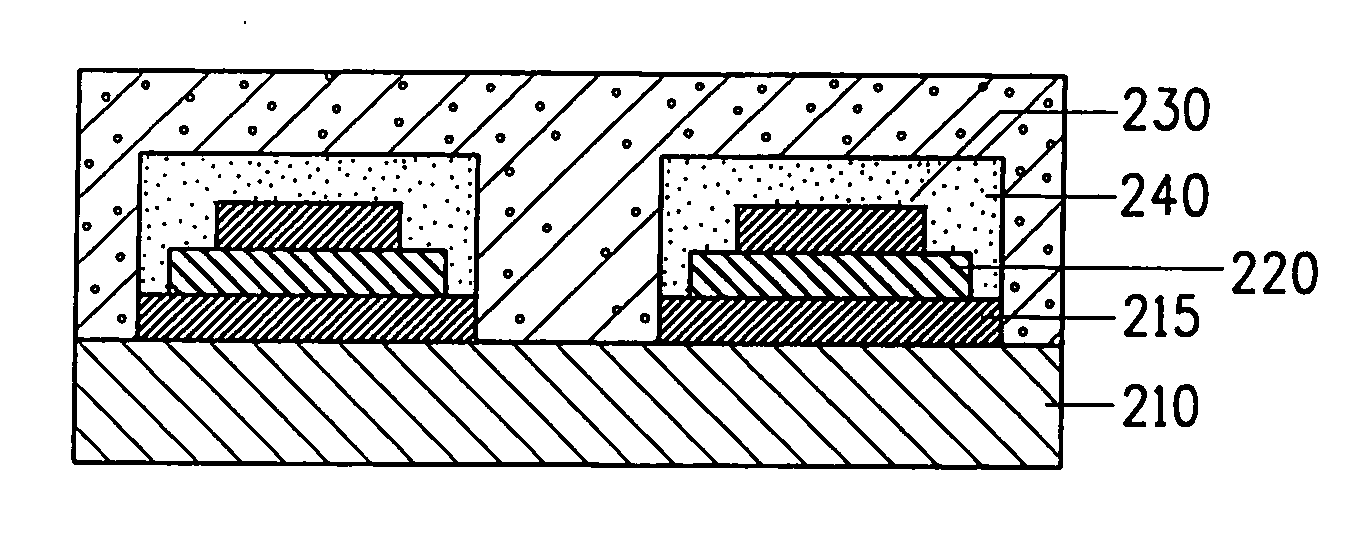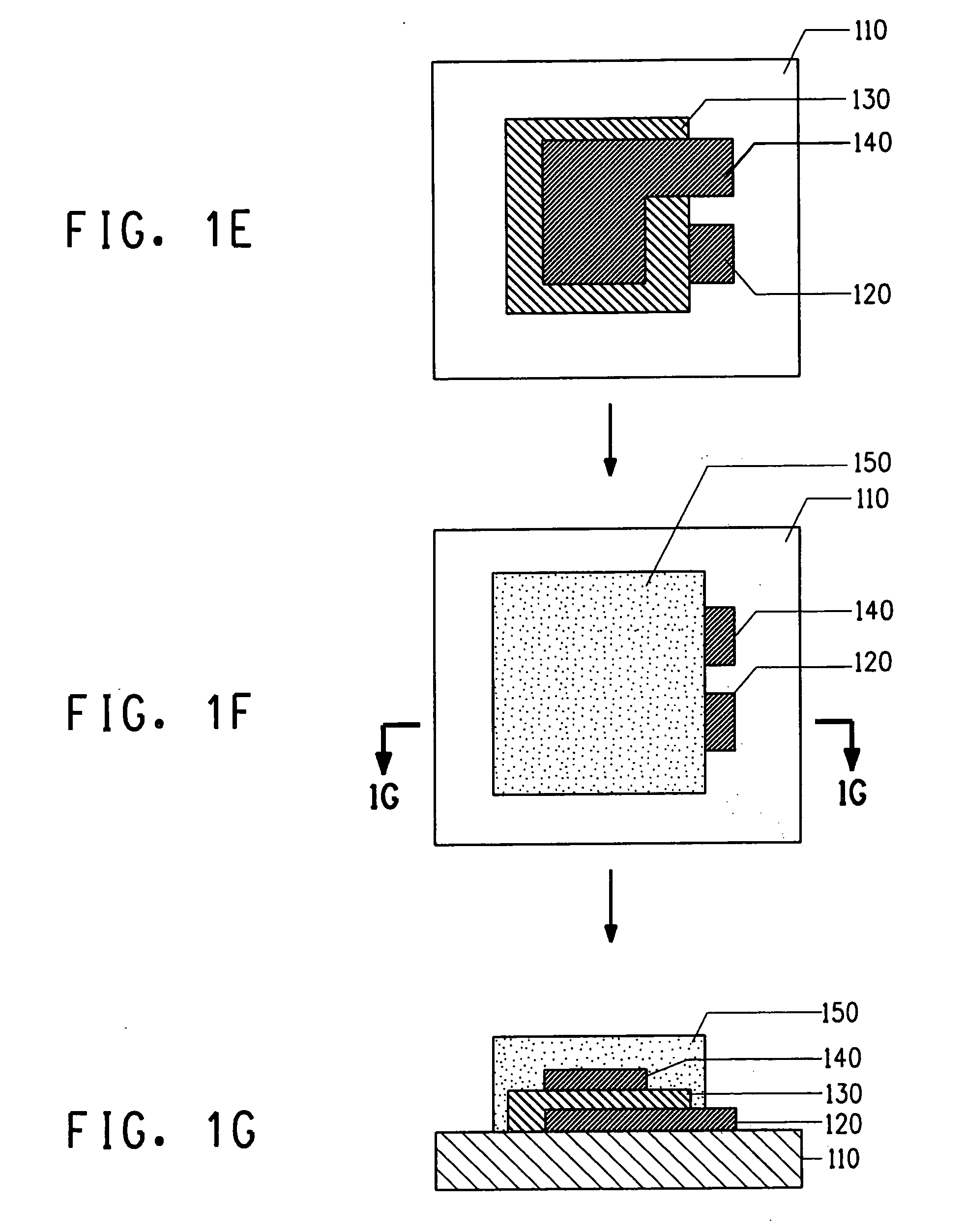Organic encapsulant compositions for protection of electronic components
a technology of organic encapsulant and electronic components, applied in the field of compositions, can solve the problems of low insulation resistance, failure, and significant degradation of insulation resistance, and achieve the effects of low insulation resistance, failure, and sustained microcracks
- Summary
- Abstract
- Description
- Claims
- Application Information
AI Technical Summary
Benefits of technology
Problems solved by technology
Method used
Image
Examples
example 1
[0066] An encapsulant composition was prepared according to the following composition and procedure:
MaterialWeight %Epoxy-PNB pre-dissolved in23.37dibutyl carbitol at 50.0% solidsESD-1819 pre-dissolved in23.37dibutyl carbitol at 50.0% solidsN,N-dimethylbenzylammonium0.47acetateTitanium dioxide powder31.67Alumina powder21.12
The mixture was roll milled with a 1-mil gap with 3 passes each at 0, 50, 100, 200, 250 and 300 psi to yield well dispersed paste.
[0067] Capacitors on commercial 96% alumina substrates were covered by encapsulant compositions and used as a test vehicle to determine the encapsulants resistance to selected chemicals. The test vehicle was prepared in the following manner as schematically illustrated in FIG. 1A through 1G.
[0068] As shown in FIG. 1A, electrode material (EP 320 obtainable from E. I. du Pont de Nemours and Company) was screen-printed onto the alumina substrate to form electrode pattern 120. As shown in FIG. 1B, the area of the electrode was 0.3 inch...
example 2
[0074] An encapsulant composition was prepared using the following ingredients and processes:
Preparation of Epoxy Medium
[0075] Ingredients:
Terpineol300 gAvatrel 2390 epoxy resin (AV2390)200 g
[0076] A 1 liter resin kettle was fitted with a heating jacket, mechanical stirrer, nitrogen purge, thermometer, and addition port. The terpineol was added to the kettle and heated to 40° C. After the terpineol reached 40° C., the epoxy was added through the addition port to the stirring solvent. After complete addition, the powder gradually dissolved to yield a clear and colorless solution of moderate viscosity. Complete dissolution of the polymer took approximately two hours. The medium was then cooled to room temperature and discharged from the reactor. The solid content of the finished medium was analyzed by heating a known quantity of medium for two hours at 150° C. The solids content was determined to be 40.33% by this method. The viscosity of the medium was also determined to be 53.2 ...
example 3
[0086] An encapsulant was prepared with the same composition as described in example 2 except the Degussa R7200 fumed silica was substituted by Cabot Cab-O-Sil TS-530 fumed silica. The encapsulant was prepared according to the procedure outlined in Example 2
[0087] The encapsulant was printed and cured over the capacitors prepared on alumina substrates as described in Example 2. After encapsulation, the average capacitance of the capacitors was 39.2 nF, the average loss factor was 1.5%, the average insulation resistance was 2.3 Gohms. The coupons were then dipped in a 5% sulfuric acid solution at room temperature for 6 minutes, rinsed with deionized water, then dried at 120° C. for 30 minutes. The average capacitance, loss factor, and insulation resistance were 42.3 nf, 1.5%, 2.6 Gohms respectively after the acid treatment.
PUM
| Property | Measurement | Unit |
|---|---|---|
| water absorption | aaaaa | aaaaa |
| temperature | aaaaa | aaaaa |
| water absorption | aaaaa | aaaaa |
Abstract
Description
Claims
Application Information
 Login to View More
Login to View More - R&D
- Intellectual Property
- Life Sciences
- Materials
- Tech Scout
- Unparalleled Data Quality
- Higher Quality Content
- 60% Fewer Hallucinations
Browse by: Latest US Patents, China's latest patents, Technical Efficacy Thesaurus, Application Domain, Technology Topic, Popular Technical Reports.
© 2025 PatSnap. All rights reserved.Legal|Privacy policy|Modern Slavery Act Transparency Statement|Sitemap|About US| Contact US: help@patsnap.com



